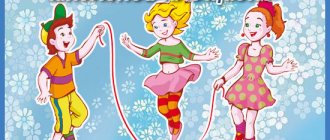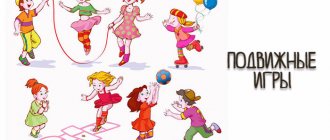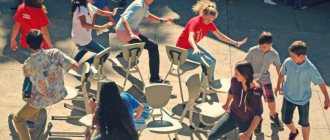Quiet games during breaks at school
- Caricature . Children sit in a circle. Everyone comes up with ideas and takes turns portraying someone present. Everyone is trying to guess. If they guess right, that child is eliminated. If not, the one who portrayed is eliminated. The last and most persistent win.
- Alphabetically . Children are asked to line up within a certain time so that all names are in alphabetical order. You can modify the game: for example, so that the guys line up by hair color. You can also invite children to line up on a bench without stepping on the floor.
- Guess who spoke . The driver is blindfolded. The players form a circle around him, walk and sing any song. When the driver says: “Stop,” he points his hand in front of him. The one pointed to sings a few words from that song in a changed voice, and the presenter guesses this person. If you guessed right, they change places, if not, then they start over.
- Brook . An odd number of children is required. The players are divided into pairs. These couples form a corridor with their hands up. The participant without a partner from the end passes through the stream and chooses a friend, and they stand in front. The one from whom he took the pair is now looking for a new one.
- Brush . Children stand close to each other and walk in a circle. The driver is in the middle. The players pass the brush from hand to hand, and everyone pretends to pass it. The driver must see where the brush really is and say: “Hands!” He points to the suspect. If he has a brush, then this child is the new driver. If not, then whoever actually had the brush can brush the driver's back.
Examples of fun games
“Catch the ball” (for preschoolers - children of primary school age)
Children receive one or more balloons (depending on the number of participants). The guys' task is to prevent the balls from touching the floor, constantly forcing them to fly up.
“The slower you go, the further you go” (for any age)
Two lines are drawn - start and finish (the distance between them is about 30 m). The leader stands at the finish line, the rest at the start. The presenter turns away and says the words:
"The quieter you go, the further you'll get".
While the leader speaks, the rest try to run as far as possible. The presenter, having finished speaking, turns sharply.
At this moment everyone should freeze. The player who does not have time to stop is sent back to the start. The players' task is to get to the finish line as quickly as possible.
"Jumping in bags" (for any age)
The guys are divided into 2 or more teams. Each team has a bag.
Children take turns jumping in bags to the set mark and returning back.
All team members must complete this task. The team's goal is to finish faster than their opponents.
The fastest team wins.
Outdoor games are an excellent way to develop skills in a child. While children are having fun and having fun, physical activity has a positive effect on their health, increases endurance and agility, and teaches children how to work as a team. Thus, the child develops while doing what interests him.
Precautionary measures
When conducting outdoor games, it is worth remembering safety precautions. Failure to comply with safety precautions can lead to injuries and other unpleasant consequences, so it is important to familiarize children with the rules of the game, indicate the territory in which it will be played, tell them what to do if they fall, etc.
Basic rules for outdoor games:
- Play on a safe surface: flat, without unexpected holes or bumps, preferably not too hard. The ideal surface is grassy.
- Do not play outside during or immediately after rain as the ground becomes slippery.
- If the game is played indoors, make sure it is large enough.
- Do not play games near roads or parking lots. The best place is a specially equipped closed area.
- If you use sports equipment (ball, rope, jump rope), make sure it is in good working order and tell your children about the rules of use. Make sure the guys stick to them.
- Check your children's shoes: they should be comfortable, fit firmly on the feet, and not cause difficulties when running. Clothing must also be appropriate. Do not neglect your hat if the game is played outside on a sunny day.
- If necessary, use protection: helmet, knee pads, elbow pads.
- You can prepare water so that the guys can quench their thirst after the game.
If one of the children is injured, provide first aid and, if necessary, take him to a place where he will receive qualified assistance.
Distribution of game roles among schoolchildren
There are several ways :
- All kinds of little rhymes.
- Using pinwheels (for example, skittles).
- The adult himself appoints the main roles, but the choice must be justified.
- Children assign roles themselves.
The best conflict-free way is to use a counting rhyme.
Nowadays, schoolchildren spend a lot of time sitting. Whatever the game, it should give the child the opportunity to move. Rest assured, all children love to play, especially if it's a chance to take a break from studying.
2015-04-10
football
Least traumatic outdoor games for schoolchildren
- Tamer of wild animals.
It is necessary to bring chairs, and their number should be one less than the number of players. One of the children is a “tamer”; the rest invent animals for themselves and sit on chairs. The “tamer” slowly walks in a circle and pronounces different names of animals. The one who is named stands behind the driver and follows him. When the “tamer” says: “Attention, hunters!”, everyone, including him, runs to take their places on the chairs. The one who was left without a place is now a “tamer”. - Fifteen.
The players stand in a circle, one of them has a ball in their hands. When he throws a ball to someone, he says: “One!” Next, the guys throw the ball and silently count to fifteen. The participant who has the ball in his hands at the count of fifteen throws it into the center of the circle. If this does not happen, then this player squats in a circle and waits to be knocked out. - Herring in a barrel.
All players count to ten with their eyes closed. At this time, the leader hides. Then the children take turns looking for it for one minute. If the child does not find a leader within the specified period, then he drops out. If found, he hides with him. And this happens with each subsequent player. At the end of the game, the children sit in one place, like sardines in a barrel. - Ogre. The “ogre” sits with his eyes closed. Other participants touch him. Whoever the “cannibal” manages to grab by the hand becomes the “cannibal” in his place.
- A mischievous round dance.
The driver is blindfolded, and a circle is formed around him. A child in a circle puts one hand on his belt and extends the other to the side. A player is pre-designated to say “stop.” The round dance begins to move in one direction, and the leader in another. At the same time, he mentally lists different words, for example, the names of animals or professions. When the chosen child says "stop", everyone stops. The driver's eyes are untied, and he voices the word he stopped on. The player to whom his hand was pointing artistically depicts what the spoken word means (for example, a cat). Everyone laughs and clapping. Now this player is the driver.
Indoor activity games
- Three, thirteen, thirty. Children sit in a circle, with the driver in the middle. He names numbers that represent certain actions, and everyone else must carry them out. For example, 3 – clap your hands, 13 – sit down, 30 – walk in place.
- Fishing rod. A circle is formed around the driver. He spins himself and spins the jump rope, while the other participants jump up to avoid being hit by the jump rope. Whoever is hit is eliminated from the game.
- Pass the hat. A circle is built, and inside it is a smaller circle. One participant in each circle has a hat on his head. It is necessary to pass the hat onto the neighbor’s head in a circle without using your hands.
- Traffic light.
The presenter is turned away from the other participants and is at some distance from them. He calls the light that is now at the traffic light. If he calls green, the children go. If it is red, they must stop immediately. Having named the color, the driver looks around. If someone does not have time to stop, then he leaves the game. They continue to play until someone touches the driver’s back or until there are no players left. - Fruit basket.
Children stand in a circle. Everyone comes up with their own fruit. In the middle is the “buyer”. The players ask him: “What did you buy?” He answers: “I was at the market, brought an orange and an apple” (any fruit can be called). The guys with the names of these fruits run to each other’s places, and the “buyer” runs to an empty place. The participant who was left without a seat is now the driver.









